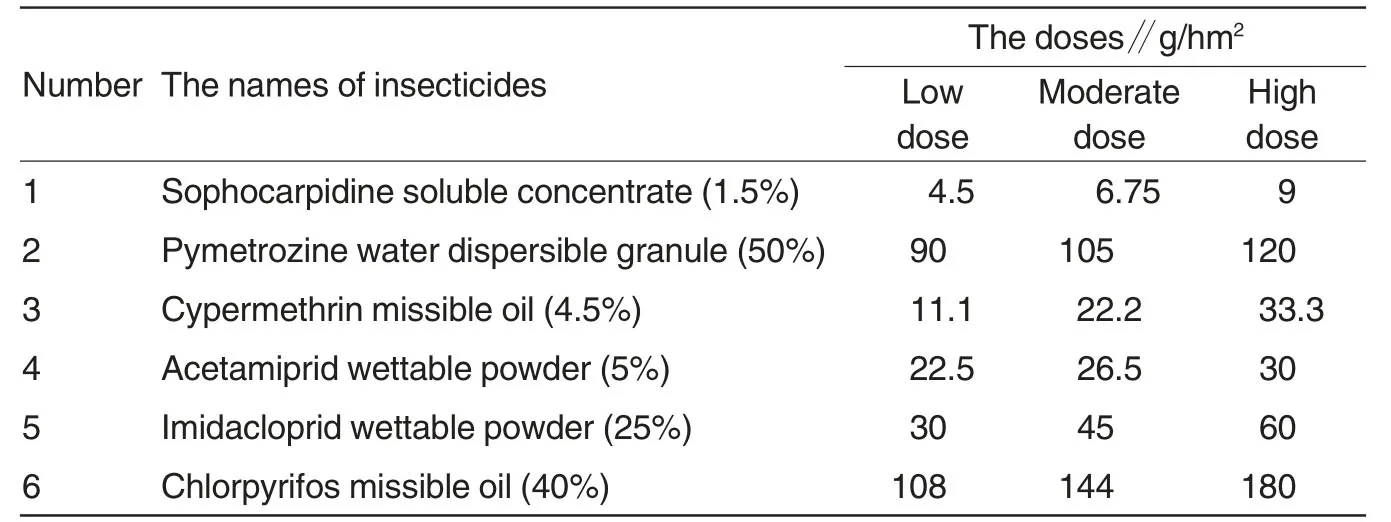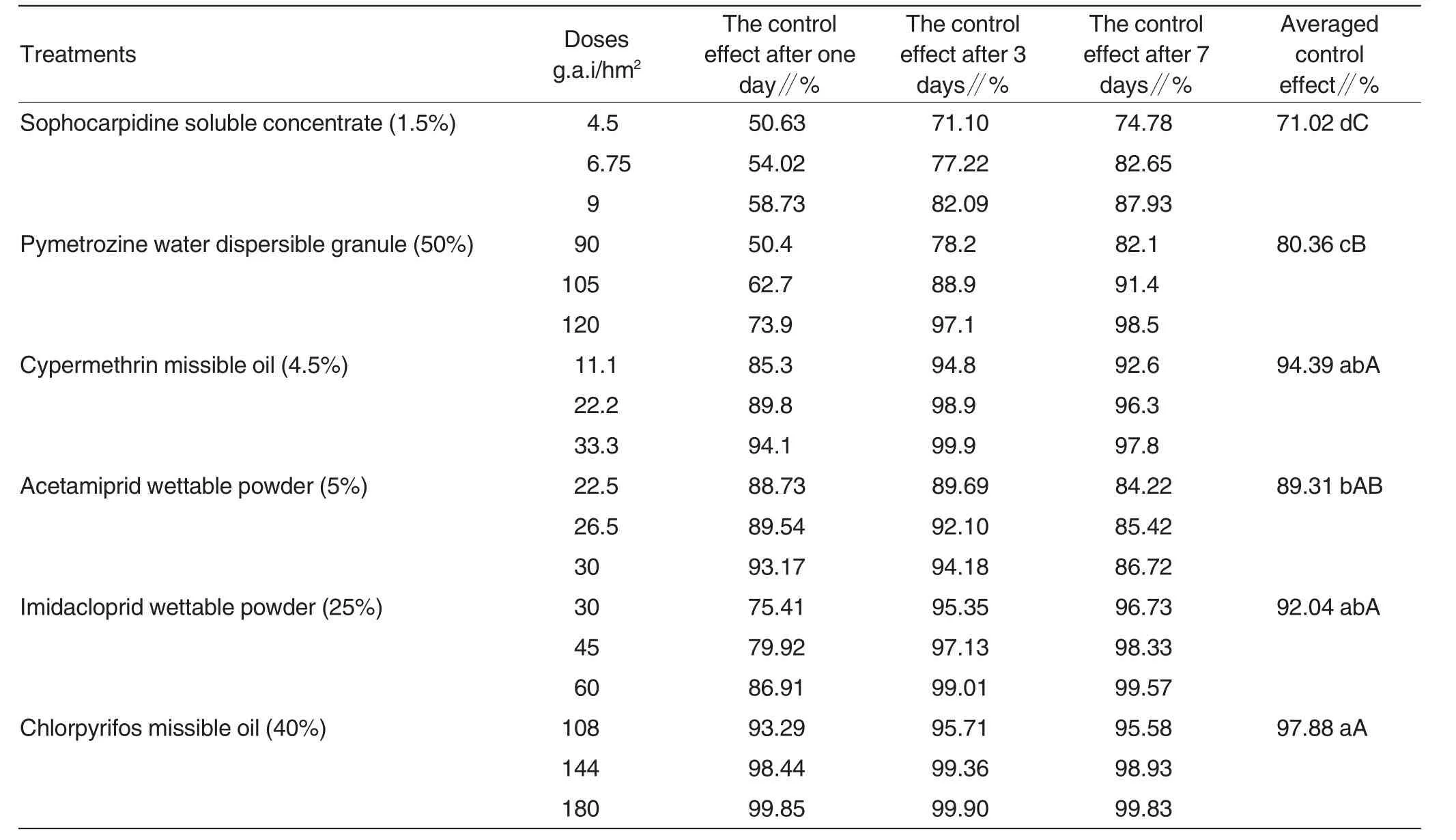Research on the Control Effects of Several Insecticides on Wheat Aphids
2015-01-18XianyanSUFeiHUXuexiangRENZhengheYEXuechengZHANG
Xianyan SU,Fei HU,Xuexiang REN,Zhenghe YE,Xuecheng ZHANG
1.Institute of Plant Protection and Agro-Products Safety,AAAS,Hefei 230016,China;
2.Institute of County Agricultural Science Research of Shouxian Anhui,Shouxian 232200,China
Responsible editor:Xiaoxue WANG Responsible proofreader:Xiaoyan WU
Aphids are among the most destructive insect pests on wheat in growing areas in Anhui Province,and they are small sap-sucking insects,spreading diseases,such as yellow dwarf virus[1-2].If not well controlled timely,aphids would cause serious loss[3].Currently,however,the wheat varieties tolerant to aphids are deficient[4-5],and the control on aphids mainly depends on insecticides[6].There are various insecticides that can be used to control aphids,including sophocarpidine,pymetrozine,betacypermethrin,acetamiprid,imidacloprid,and chlorpyrifos.The research explored control effects of the 6 insecticides and recommended the optimal doses.
Materials and Methods
Test materials and demonstration fields
The wheat variety was Xinmai No.26;soils are yellow soils,with moderate fertility and pH of 6.8.The cultivation conditions were the same as per local method.
Test insecticides
Test methods
Test designThe test included 19 treatments,containing 6 insecticides,and every insecticide was designed with three doses.Besides,a control group was set with clean water.Every treatment was 25 m2,with four replications and every test plot was conducted as per randomized block arrangement.
Applying insecticidesAccording to insect population density in farmlands,insecticides were applied once on April 29,2014.It is notable that the insecticide was applied during grain-filling stage of wheat,when insect population density reached 700 insects every hundred plants.
Test instrumentsThe test instruments included a 3WBD-18 backpack electric sprayer,with working pressure of 0.15-0.4 mpa.The sprayer aperture is 1.44 mm.
Insecticide applying methodThe test insecticides were extracted with apipette as per test plot area and then well mixed with water in a plastic bucket.Subsequently,the mixtures were poured into the sprayer and applied at 750 L/hm2.

Table1 Test insecticides and doses
Survey method and data processing
Survey time and frequencyThe number of aphids was surveyed four times on April 29 (before applying insecticides),April 30 (one day after applying insecticides),May 2 (three days after applying insecticides) and May 6(7 days after applying insecticides).
Survey methodIn every test plot,5 sites were sampled to research 20 ears and record the number of aphids.
The calculation method of insecticide effectsThe reduction rate of pest population density//%=(The number of pest before applying insecticides-The number of pest after applying insecticides)/The number of pest before applying insecticides×100;
The prevention effects//% =(The reduction rate of pest population density in test area-Reduction rate of pest population density in the control)/(100-reduction rate of pest population density in the control)×100.
Results and Analysis
Analysis on control effects of the 6 insecticides
As shown in Table2,all of the 6 insecticides have significant effects on controlling aphids on wheat.Specifically,40%chlorpyrifos missible oil performed the best in terms of control effect.For example,the control effect exceeded 93% only one day after applying the insecticide.Secondly,4.5%cypermethrin missible oil,25% imidacloprid wettable powder,and 5% acetamiprid wettable powder performed better.Besides,the control effects of 50% pymetrozine water dispersible granule and 1.5% matrine soluble concentrate were the poorest.Still,for all of the insecticides,3 and 7 d after applying,the control effects proved well on aphids and the control effect reached over 80% for the insecticides with moderate doses.On basis of analysis of variance,the control effects tended to be volatile upon insecticides.For example,the control effects of 40% chlorpyrifos missible oil,4.5%cypermethrin missible oil and 25%imidacloprid wettable powder proved higher,showing extremely significant differences with 1.5% matrine soluble concentrate and 50% pymetrozine water dispersible granule,and significant differences with acetamiprid wettable powder.
Analysis of the insecticides with different doses on control effects
Sophocarpidine soluble concentrate (1.5%) was applied at 4.5,6.75 and 9 g/hm2,and the control effects reached 51.51%,56.61% and 59.16%one day after applying the insecticide and 76.39%,84.45%and 87.00%after 7 days.According to analysis of variance,the treatments showed little differences one day after applying the insecticide,but significant differenceswere shown among treatments with high and low doses 7 d after applying the insecticide.Pymetrozine water dispersible granule (50%) was applied at 90,105 and 150 g/hm2,and the control effects were 50.4%,62.7%and 73.9% one day after applying the insecticide and 82.1%,91.4% and 98.5% 7 d after applying the insecticide.According to analysis of variance,the treatment with 90 g pymetrozine water dispersible granule showed significant differences with the treatment with 105 g the insecticide and the control with 105 g the insecticide,and extremely significant differences with the treatment with 120 g the insecticide; the treatment with 105 g the insecticide was of significant differences with the treatment with 120 g the insecticide one day after applying the insecticide.Cypermethrin missible oil (4.5%) was applied at 11.1,22.2 and 33.3 g,and the control effects reached 85.3%,89.8%and 94.1%one day after applying the insecticide and 92.6%,96.3%and 97.8%after 7 days.According to analysis of variance,extremely significant differences were shown among treatments after one day,and the treatment with 11.1 g the insecticide showed extremely significant differences with the treatment with 33.3 g the insecticide and significant differences with 22.2 g the insecticide.Acetamiprid wettable powder(5%) was applied at 22.5,26.25 and 30 g,and the control effects reached 89.69%,92.10% and 94.18% 3 days after applying the insecticide and 73.16%,75.44% and 78.37% after 7 days.Imidacloprid wettable powder(25%)was applied at 45,60 and 75 g,and the control effects reached 75.41%,79.92% and 86.91% one day after applying the insecticide and 96.73%,98.33% and 99.57% after 7 days.After one day,the treatments with moderate and high doses showed insignificant differences and significant differences between the treatments with high and low doses.As for 40%chlorpyrifos missible oil,it was applied at 108,144 and 180 g,respectively.The control effects reached 93.29%,98.44% and 99.85% one day after applying the insecticide,which suggested that the treatment with low dose showed extremely significant differences with the treatments with moderate and high doses,and the control effects were 95.58%,98.93% and 99.83% after 7 days,which indicated that the control effects tended to be volatile upon treatments and the treatment with low dose showed extremely significant differences with the treatment with high dose.

Table2 The test results of control on aphids on wheat by 6 insecticides
Effects on crops
Based on successive observations 14 days after applying insecticides,the 6 insecticides had none adverse effects on wheat.
Conclusions and Discussions
Sophocarpidine soluble concentrate (1.5%),pymetrozine water dispersible granule (50%),cypermethrin missible oil (4.5%),acetamiprid wettable powder (5%),imidacloprid wettable powder (25%),and chlorpyrifos missible oil(40%)all performed well in controlling wheat aphids,with low toxicity,and proved environment-friendly.
During initial diseasing stage of aphid,it is recommended to use sophocarpidine soluble concentrate(1.5%),pymetrozine water dispersible granule (50%),imidacloprid wettable powder (25%),and acetamiprid wettable powder (5%) for controlling at 6.75-9,105-120,30-45 and 26.25-30g.a.i/hm2,and 40% chlorpyrifos missible oil,cypermethrin missible oil(4.5%)and imidacloprid wettable powder(25%)can be applied in peak-diseasing stage at 108-144,22.2-33.3 and 45-60 g.a.i/hm2.
Considering drug resistance,different insecticides and controlling time should be determined in accordance with specific wheat aphid.
[1]MIAO K(缪康),SHU ZL(束兆林),JI MX(吉沐祥),et al.Control effect of emamectin benzoate chlorantraniliprole 25%EW to wheat aphids(25%甲维·毒死蜱水乳剂对小麦蚜虫的防治效果)[J].Jiangsu Agricultural Sciences(江苏农业科学),2010(6):199-200.
[2]DING JH(丁锦华),SU JY(苏建亚).Agricultural entomology (农业昆虫学)[M].Beijing:China Agriculture Press (北京:中国农业出版社),2001:253-258.
[3]LI ZM (李智民).Control effects of 2.5%cyhalothrin microemulsion on wheat aphids (2.5%高效氯氟氰菊酯微乳剂防治小麦蚜虫效果研究)[J].Modern Agricultural Science and Technology (现代农业科技).2015(2):128.
[4]LI YG(李玉刚),GAI HM(盖红梅),WANG RY(王瑞英),et al.Control effects of four insecticides on wheat aphids in farmlands(四种杀虫剂对小麦蚜虫的田间防治效果评价)[J].Shandong Agricultural Sciences (山东农业科学),2014,46(5):107-108.
[5]ZHAO JH(赵玖华),SHANG YF(尚佑芬),WANG SJ (王升吉).Identification of multi-resistance of 152 wheat varieties(strains)in Huanghuai region(152个黄淮地区小麦主要品种(系)的多抗性鉴定)[J].Journal of Triticeae Crops(麦类作物学报),2007,27(6):1123-1127.
[6]WANG HF(王汉芳),JI SQ(季书琴),LI XD (李向东),et al.Control effects of 10.4% imidacloprid diniconazole on wheat aphids and banded sclerotial blight(10.4%吡虫啉·烯唑醇悬浮种衣剂对小麦蚜虫和纹枯病的防治效果).Journal of Triticeae Crops (麦类作物学报),2012,32(4):799-804.
猜你喜欢
杂志排行
Agricultural Science & Technology的其它文章
- Simplified Cultivation Technology of Hua’an No.513——A New Summer Maize in Suixi County
- Research Progress on Heavy Metals Detoxification in Human Body
- The Strategies of Rainfall Accumulation and Utilization in New Countryside
- Advances in the Study of Protein Quality Traits and Main Influencing Factors of Wheat in China
- DNA Extraction from Half-grain Wheat Seeds without Using Chloroform
- Purification and Antimicrobial Assay of an Antimicrobial Protein from a Biocontrol Bacterium Strain K2-1 against Aquatic Pathogens
